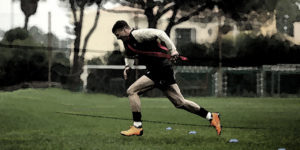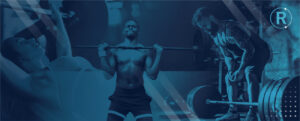Post broken-leg workouts to fuel your rugby comeback
- Tim Howard
- Training
Of all the injuries you are likely to suffer playing rugby, a broken leg is arguably the most traumatic. Whether it’s the tibia, fibula, or femur, a broken leg bone means many weeks of rest and recovery, and a lengthy period of rehab.
Because there are different types of fracture, it’s impossible to say how long a broken leg will keep you out of the game. It also depends on which bone you break.
For example, the tibia and the femur are both thick weight-bearing bones which will probably take longer to heal than the thinner, non-weight bearing fibula. You may even be unlucky enough to break the tibia AND fibula – the twofer that nobody wants.
With any sort of fracture, you should always defer to the advice of medical professionals. Make sure you not only follow your doctor’s advice but also do what your physical therapist tells you to do. After all, they are the experts! Rushing back into training could delay the recovery process and even result in re-fracture.
Once you’ve been given the all clear to return to training, it’s time to start planning your glorious return to rugby.
Because rugby is such a physically demanding sport, it is critical that you don’t return to competitive rugby until you are 100% ready. After all, the last thing you want to do during your first match back is get injured again.
Training while injured
Ruggers are notoriously dedicated (or stubborn!) athletes. After all, it takes a very special sort of person to play such a demanding sport. Minor injuries are often trained around or ignored for weeks or even months at a time. Show me a rugger who isn’t training and playing with at least a couple of minor injuries and I’ll show you a player who isn’t getting stuck in!
Because of this, it’s very unlikely you are going to want to give up training altogether – even if you have a broken leg.
In fact, a complete break from training is a bad idea. After all, you’ll gain weight during your layoff and then, when you return to training, you’ll have to restore lost fitness and strength while rehabbing your injury. A complete training break can also be very demoralizing and that can have a negative impact on your recovery.
The good news is that, soon after suffering your fracture, you can and should be able to do at least some training to maintain your fitness.
For starters, you should be able to return to upper body training a couple of weeks after your fracture. You will need to modify some of the exercises in your workout to allow for the fact you’ll be using crutches to get around and will have your injured leg in plaster, but that doesn’t mean you can’t continue to work on your upper body strength. You may also need help loading and unloading bars and fetching and carrying dumbbells. Your fellow ruggers should be more than willing to lend a hand so you can train safely and effectively.
You’ll also have to build your workouts around seated and lying exercises – standing exercises are out for the time being.
Example workout:
- Barbell bench press 4 sets 6-8 reps
- Incline single-arm bench press 3 sets 10 reps
- Lat pulldowns 4 sets 8 reps
- Chest supported row 3 sets 10 reps
- Seated dumbbell shoulder press 3 sets 12 reps
- Seated dumbbell biceps curl 2 sets 10 reps
- Dumbbell skull crushers 2 sets 10 reps
- Cable abs crunches using lat pulldown machine 3 sets 15 reps
Cardio fitness is likely to be harder to maintain as most cardio exercises involve the lower body. However, if you have access to an upper-body air bike, or a Grappler, you should still be able to do at least some cardiovascular training. You could also use battle ropes while sitting on an exercise bench or sturdy chair.
Maintain strength in your injured leg by training your uninjured leg
One of the worst aspects of breaking your leg is that your injured limb will have to be immobilized and you’ll have to keep your weight off it. This causes a very rapid loss of muscle – properly called atrophy.
Muscle atrophy starts soon after injury and means that, when the plaster cast comes off, your previously muscular leg will have all-but withered away. Muscle mass can be restored relatively quickly, but as the saying goes, an ounce of prevention is worth a pound of cure.
It may be possible to reduce loss of strength and muscle mass in your injured leg by continuing to train your non-injured leg. Research suggests that training your non-injured side can have a positive effect on your injured side (1). This is called “cross education”. Exercises like single-leg leg extensions, leg curls, and leg presses may help preserve at least some of your muscle strength and size.
Restoring lost flexibility and mobility
Once your plaster cast has been removed, your priority should be restoring lost flexibility and mobility. Flexibility and mobility are similar but different. Flexibility refers to the elasticity of muscles while mobility is the free movement of joints.
Forced immobilization will not just cause your muscles to atrophy; they’ll also tighten and shorten. If you try to return to training without addressing these issues, your movements will be impeded, and you could end up creating more problems.
The good news is that flexibility and mobility exercises are relatively low stress, so you can do them several times a day – even while watching TV. Your physical therapist should be able to provide you with a progressive mobility and flexibility program to follow that is specific to your injury.
Doing too much too soon could result in a setback, delaying your recovery. Exercise caution and take things slowly. Some discomfort and pain are unavoidable – after all, you broke your leg, man! But you need to make sure you don’t rush your recovery as that could mean you end up taking more steps back than you take forward. Listen to your body and adjust your flexibility and mobility regimen accordingly.
Restoring lost stability and balance
Once you are given the go-ahead to return to weight-bearing activity, your next priority should be restoring lost joint stability and balance. The combination of inactivity and immobility will mean that your balance and joint stability will be severely degraded. After all, you will have just spent weeks and months gimping around on one leg!
Initially, just walking unaided will challenge your balance and stability. But, once you can walk reasonably well, it’s time to start working on these elements specifically. Exercises such as standing on one leg, heel-toe walking along a line, single leg calf raises, and any other single leg exercise will help restore your stability and balance.
Again, your physical therapist will be able to provide you with detailed instructions on what to do and what not to do. You’ll also find information on stability and balance training for rugby here.
Getting back to real rugby training
Once you have received the nod from your doctor to return to “real” training, you might be tempted to pick-up from where you left off. Don’t!
Even if you have followed all the advice in this article, you’ll still be relatively de-trained and jumping right back into full training could set you back several weeks or even months. Instead, make “light and easy” your workout mantra and leave your ego outside the gym.
Initially, leg extensions, leg curls, and leg presses should be your bread and butter, with squats, deadlifts, lunges, and step ups coming a few weeks later. Plyometrics should be reserved for when you are back to 100% fitness.
When you do return to squats, deadlifts etc. consider starting out with an empty barbell. Gradually add 2.5-5.0 kg to the bar each week, never forcing your return to fitness. Monitor how your workouts affect you and make sure you back off if you feel unwarranted pain. Muscle soreness is normal; bone or joint pain is not. Slow but sustained progress is better than fast and then stalled progress. In many cases, light but frequent workouts are better than heavier but more infrequent workouts – at least in the early stages of restoring lost fitness and strength.
For cardio, running is off the menu for the time being so consider non-weight bearing activities such as deep water running, swimming, and rowing. When you get the go ahead for more weight bearing activity, choose low impact workouts such as cycling, sled training, or the elliptical. For more non-running cardio workouts, check out this article.
Only return to running when given the go-ahead to do so, and even then, do so very cautiously. Adhere to the 10% rule – never increase the duration of any one workout or your weekly running total by more than 10% at a time.
It goes without saying that we hope you never need to use the information in this article. However, if you are unlucky enough to break a leg playing rugby, remember that you aren’t the only rugger that it’s happened too, and most players go on to make a full recovery. If you are looking for injury recovery inspiration, makes sure you check out our My Injury article series.
References
1.Cross-Education Strength and Activation After Eccentric Exercise


